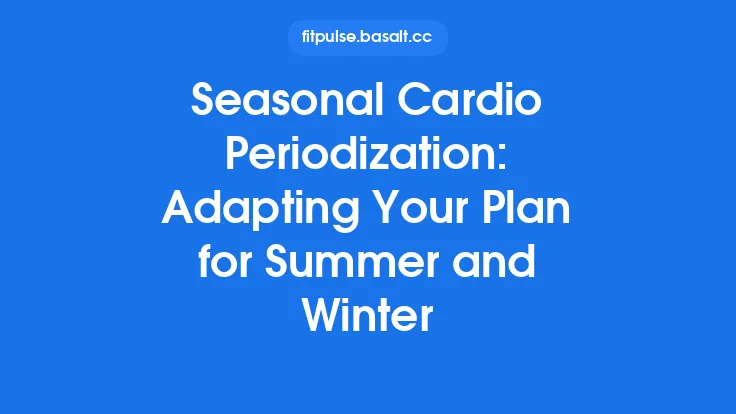Seasonal changes bring more than just a shift in wardrobe; they alter the very environment in which our bodies move. Temperature fluctuations, humidity levels, daylight hours, and the types of activities we gravitate toward each season all influence how our muscles, tendons, ligaments, and joints respond to movement. By understanding these variables, you can fine‑tune your mobility flow sequences to maintain optimal range of motion, joint health, and movement quality year‑round.
Understanding Seasonal Influences on Mobility
Physiological climate response
- Thermoregulation: Cold exposure triggers vasoconstriction, reducing blood flow to peripheral tissues and increasing muscle stiffness. Heat, conversely, promotes vasodilation, enhancing circulation but also raising the risk of dehydration and altered proprioception.
- Synovial fluid dynamics: Synovial fluid becomes more viscous in low temperatures, limiting joint lubrication. Warmer environments increase fluid turnover, which can improve glide but may also accelerate wear if movement volume is excessive.
- Collagen cross‑linking: Repeated exposure to cold can increase non‑enzymatic glycation of collagen, subtly reducing tissue extensibility. Seasonal shifts in diet (e.g., higher sugar intake in winter) can compound this effect.
Behavioral patterns
- Activity focus: Winter often emphasizes indoor, low‑impact activities (yoga, pilates, indoor cycling), while summer encourages outdoor, high‑impact pursuits (running, climbing, water sports).
- Training volume: Holiday periods may lead to reduced training frequency, whereas spring and fall often see a surge in outdoor training sessions.
Recognizing these patterns allows you to anticipate the specific mobility demands each season will place on your body.
Thermal Effects on Muscle and Joint Physiology
| Temperature Range | Primary Muscular Impact | Joint Considerations | Recommended Flow Adjustments |
|---|---|---|---|
| Below 5 °C (Freezing) | Increased muscle tone, reduced elasticity, heightened risk of strain | Synovial fluid thickens, joint glide slows | Longer dynamic warm‑ups, incorporate active joint mobilizations before static stretches |
| 5 °C – 15 °C (Cool) | Moderate stiffness, slower contraction speed | Slightly viscous synovial fluid | Gradual progression from low‑intensity circles to deeper ranges; add myofascial release with a foam roller |
| 15 °C – 25 °C (Mild) | Optimal elasticity, balanced contractile speed | Synovial fluid at ideal viscosity | Standard flow sequence; focus on balanced mobility‑strength integration |
| Above 25 °C (Warm) | Increased muscle compliance, potential for early fatigue | Synovial fluid very fluid, risk of over‑lubrication leading to joint laxity | Emphasize controlled, slower tempo to maintain joint stability; integrate proprioceptive drills |
Adapting Flow Sequences for Cold Weather
- Extended Dynamic Warm‑Up
- Begin with low‑intensity cardio (e.g., marching in place, light jump rope) for 5–7 minutes to raise core temperature.
- Follow with joint‑specific circles (ankle, knee, hip, shoulder) performed in a controlled, progressive range.
- Layered Mobility
- Phase 1 – Activation: Bodyweight glides (e.g., deep squat to stand, hip hinge to reverse lunge) performed with a focus on “finding” the movement rather than depth.
- Phase 2 – Progressive Stretch: Transition to deeper static holds (e.g., seated forward fold, thoracic extension on a foam roller) once the muscles feel warm.
- Incorporate Heat‑Retaining Tools
- Use heated blankets or a warm towel on the lower back or hips for 2–3 minutes before starting the flow.
- Consider a brief sauna session (if available) to pre‑warm the connective tissue.
- Mindful Breathing
- Deep diaphragmatic breaths increase internal temperature and improve oxygen delivery to stiff tissues.
Modifying Routines for Heat and Humidity
- Pre‑Flow Hydration Strategy
- Consume 200–300 ml of electrolyte‑rich fluid 15 minutes before the session. This supports synovial fluid production and reduces the risk of heat‑induced joint laxity.
- Reduced Volume, Increased Control
- Shorten the overall duration of the flow (e.g., 20 minutes) but emphasize precise alignment and controlled tempo to counteract the tendency for “floppy” joints in hot conditions.
- Cooling Intervals
- Insert brief (30‑second) “cool‑down” pauses between major movement blocks. Use these moments to sip water and perform gentle shaking of the limbs to dissipate excess heat.
- Surface Considerations
- Opt for a non‑slippery mat with good grip; sweat can compromise stability, increasing the risk of uncontrolled joint excursions.
Seasonal Activity Shifts and Targeted Mobility Priorities
| Season | Dominant Activities | Mobility Focus |
|---|---|---|
| Winter | Snow sports, indoor cardio, strength training | Hip external rotation, ankle dorsiflexion, thoracic extension (to counteract forward‑leaning postures) |
| Spring | Trail running, outdoor cycling, gardening | Hip flexor lengthening, shoulder internal rotation, lumbar flexion/extension balance |
| Summer | Swimming, beach volleyball, water sports | Shoulder external rotation, scapular stability, ankle eversion/inversion for sand stability |
| Fall | Hiking, cross‑country running, functional training | Hip adduction/abduction, ankle stability, thoracic rotation for uneven terrain |
By aligning your flow sequence with the biomechanical demands of the season’s primary activities, you pre‑emptively address the mobility deficits that commonly arise.
Environmental Variables: Surface, Altitude, and Air Quality
- Surface Compliance: Soft surfaces (grass, sand) demand greater joint stability and proprioceptive input. Incorporate balance‑oriented drills (single‑leg reaches, lateral hops) into the flow. Hard surfaces (concrete, gym floor) allow deeper static stretches but increase impact forces; integrate joint‑protective micro‑movements (e.g., ankle micro‑circles) before high‑load positions.
- Altitude: Reduced atmospheric pressure can lead to decreased oxygen saturation, subtly affecting muscle endurance. In high‑altitude settings, prioritize shorter, higher‑intensity mobility bursts with ample rest to avoid premature fatigue.
- Air Quality: Pollution or high pollen counts can irritate the respiratory system, limiting breath control. Use nasal breathing techniques and consider indoor sessions with air filtration when outdoor air quality is poor.
Integrating Seasonal Recovery Strategies
Recovery is a cornerstone of any mobility program, and seasonal factors dictate specific modalities:
- Cold‑Season Recovery: Contrast therapy (alternating hot and cold packs) can improve circulation while mitigating inflammation from colder, stiffer tissues.
- Warm‑Season Recovery: Post‑flow cooling (ice massage on large joints) helps prevent excessive synovial fluid loss and maintains joint stability.
- Nutritional Support: Seasonal produce (e.g., citrus in winter for vitamin C, watermelon in summer for hydration) can enhance collagen synthesis and joint lubrication.
Periodizing Mobility Flow Across the Year
- Macro‑Cycle (12 months) – Define three primary phases: Foundation (Winter), Transition (Spring/Fall), Peak (Summer).
- Meso‑Cycles (3‑month blocks) – Within each phase, allocate 4‑week blocks focusing on:
- Stability & Activation (first 2 weeks)
- Range Expansion (weeks 3‑4)
- Integration with Seasonal Activity (weeks 5‑8)
- Micro‑Cycles (Weekly) – Structure each week with a “load‑light” day, a “load‑moderate” day, and a “load‑heavy” day, adjusting intensity based on weather forecasts and personal energy levels.
This systematic approach ensures that mobility work evolves in tandem with external conditions, preventing plateaus and overuse injuries.
Practical Tips for Transitioning Between Seasons
- Gradual Load Shifts: Increase or decrease flow volume by no more than 10 % per week when moving from one season to another.
- Clothing Adaptability: Layer breathable, moisture‑wicking fabrics for spring/fall; add insulated, compression garments for winter to retain heat.
- Equipment Rotation: Keep a portable travel kit (resistance bands, mini‑foam roller, yoga strap) for on‑the‑go adjustments when weather forces indoor training.
- Schedule Flexibility: Build “buffer” days into your calendar to accommodate unexpected weather events (e.g., sudden snowstorm or heatwave).
Sample Seasonal Adjustments (Case Studies)
Case 1 – A Runner Transitioning from Summer to Autumn
- Challenge: Increased hill work and cooler evenings reduce muscle temperature.
- Adjustment: Add a 5‑minute dynamic “hill‑prep” circuit (high‑knee marches, walking lunges with torso twist) before the standard flow. Incorporate deeper hip flexor stretches post‑flow to counteract the added eccentric loading from downhill runs.
Case 2 – A Swimmer Preparing for Winter Indoor Training
- Challenge: Indoor pools are often cooler, and shoulder overuse is common.
- Adjustment: Begin each session with scapular wall slides and thoracic extensions using a foam roller to promote shoulder girdle stability. Follow the flow with a brief, low‑intensity “shoulder clock” mobility drill to maintain joint lubrication.
Case 3 – An Office Worker Facing a Sudden Heat Wave
- Challenge: Elevated ambient temperature leads to early fatigue and reduced concentration.
- Adjustment: Shorten the flow to 15 minutes, emphasizing slow, deliberate movements. Insert a 30‑second “air‑puff” pause after each major segment to allow evaporative cooling. Hydrate with an electrolyte solution before and after the session.
Monitoring Progress and Adjusting Load
- Subjective Metrics: Rate of Perceived Exertion (RPE) for each flow block, joint comfort scores (0‑10 scale), and temperature comfort (cold, neutral, hot).
- Objective Metrics: Range of motion measurements using a goniometer or smartphone app, heart rate variability (HRV) to gauge autonomic stress, and skin temperature sensors for localized warmth.
- Feedback Loop: Review metrics weekly; if RPE consistently exceeds 7 or joint comfort drops below 5, reduce volume or increase warm‑up duration. Conversely, if HRV improves and mobility scores rise, consider modestly increasing flow complexity.
By treating the seasons as dynamic variables rather than static backdrops, you can craft mobility flow sequences that not only preserve flexibility and joint health but also enhance performance in the activities you love throughout the year. Adjust temperature‑specific warm‑ups, align movement priorities with seasonal sports, respect environmental constraints, and continuously monitor your body’s response. The result is a resilient, adaptable movement system that thrives—whether the air is crisp, the sun is blazing, or the leaves are falling.





